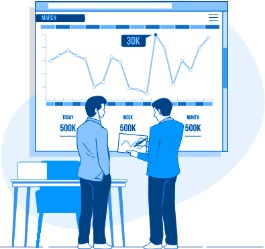Subscribe to Our Newsletter
Stay updated with the latest tips and strategies. Get additional discounts and alerts on offers.

The goal is to turn data into information and information into insights. – Carly Fiorina, CEO, Hewlett-Packard
Visual capitalists published an article in 2018 where they predicted that the amount of data generated for the healthcare industry would grow from 153 exabytes in 2013 to 2314 exabytes in 2021. One year later, the number is predicted to be even bigger, owing to the global pandemic.
Data multiplies with time. But why is focusing on the quantity of the healthcare data generated now more critical than ever?
It is because of a simple reason – like every other industry, data generation, data management, and data-driven solutions are changing the healthcare industry. You can categorize the healthcare data into two sections –
• Health tracking
• Customized care Telemedicine
• Identifying high-risk patients
• Improve patient monitoring and other patient-centric treatment activities
• Introduce new products and services
• Target niche markets
• Enhance the overall healthcare quality
• Boost marketing efficiency through data study and analysis

The competition in the healthcare industry is increasing every second. There are massive individual markets for primary care service, hospital care, medical devices, pharmaceuticals, logistics, education, human resource, and many more in the vast spectrum of the industry. The competitive market thrives on the mutually beneficial relationship between buyers and sellers.

Better decisions are a by-product of thorough research and profound analysis. This is where sourcing a reliable database comes into effect. For manufacturing, product development, marketing, and distribution, professionals can leverage a segmented healthcare database to strategize and execute better decisions. Data-driven decisions offer continual growth and produce actionable insights by predicting future trends, optimizing current operational efforts.

Data analysis is a priceless opportunity for firms to innovate. Identifying trends help medical firms to incorporate more detailed insights into the program development and planning processes leading to targeted responses and efficient resource allocation. Data also plays a significant role in the process of product/service development. According to Wharton professor of operations- Lynn Wu, lots of analytics technologies, mainly fuelled by recent advances in machine learning and the vast amount of digitalized data will offer lots of data-driven analytics, creating many incredible innovations around us.

As stated earlier, the healthcare industry is oversaturated with stiff competition. Thus, an intelligent marketing strategy that has evolved is niche marketing. It is a tactic that focuses on targeting a specific market, chosen based on factors like geography, lifestyle, profession, culture, activity or behavior, demography, and needs. Marketers build this strategy to focus exclusively on one group of potential customers who would benefit from the offerings.
Niche marketing allows brands to stand out in the crowd and increase their visibility in any corner of the world. Data sourcing and analysis come in handy here. It helps brands to understand their customers and build local strategies to resonate more deeply with the customers. By leveraging data-driven solutions, brands can reach their growth potential and build a stronger, longer-lasting connection with their ideal audience.

There are several ways to understand and mitigate problems that emerge in a competitive market, but the best way is by data analysis. Data visualization is critical to guarantee that the decision made is right. The first step to ensure that data drives your future decisions and helps solve problems more efficiently. The first step to creating a relevant data visualization is to find the correct data. Understanding how your data is sourced, verified, stored, and updated is vital to solving problems. More importantly, it helps in confirming that the data used is highly relevant.

Businesses are changing their game plan to ace their marketing strategies. Without a proper data quality updating strategy in place, data loses its value. So, to compete in an ever-changing business landscape, it is necessary to build an efficient marketing budget and execute it strategically.
When you have an exact database of the leads that you want to target, this helps you streamline the goals of your sales and marketing team and focus your budget on the most vital aspects of the brand’s goals. It stands true when the marketers are planning to go ahead with niche marketing.
The primary sources of collecting healthcare data are surveys, administrative and medical records, claims data, vital records, surveillance, disease registries, and peer-reviewed literature.
However, there is an easier and more effective alternative to it. One can buy the services of a professional B2B database provider specializing in high-quality healthcare databases.
We are one such premium healthcare database provider assisting with company and contact data for more than half a decade. With over 93M+ contacts from 170+ countries, you can target key decision-makers, heads, and other high-profile accounts from the healthcare sectors. Avail from contact details of niche sectors of the healthcare industry ranging from hospitals, clinics, educational institutions, pathology labs, trauma centers, and many more.
Collecting healthcare data encourages efficient communication between patients and care providers, which ultimately increases patient care quality. Updated and accurate data can significantly improve the output. However, with the intelligent adaptation of modern technologies, one can cope with vast volumes of information, leading to better performance, increased revenues, and better utilization of time.
Show Some Love!

Subscribe to Our Newsletter
Stay updated with the latest tips and strategies. Get additional discounts and alerts on offers.
Related Articles
Subscribe to Newsletter
Stay up to date with the latest marketing, sales, and service tips and news.
